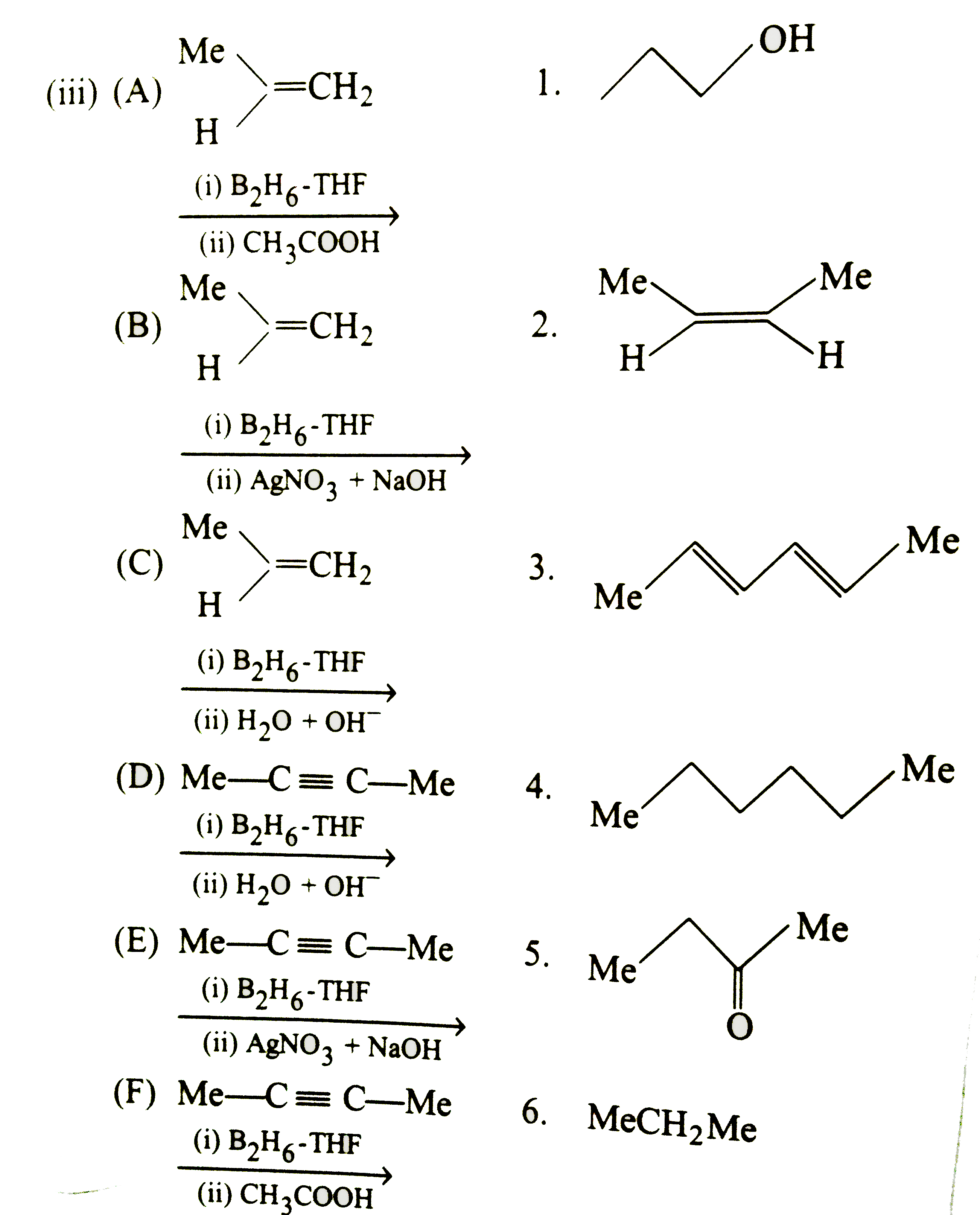Match the following
DiseaseCauseA.Diabetes1.Rise in WBC countB.Uraemia2.Deficiency of vitaminB12C.Anaemia3.Rise in RBC countD.Polycythemia4.Fall of WBC countE.Pernicious or Megaloblastic anaemia5.Falls in RBC coountF.Leukemia6.Increase in blood sugar levelG.Thrombocytopenia7.Urea is in excess in bloodH.Leucopenia8.Pathological increase in WBCI.Leucocytosis9.Decrease in the number of platelets
The correct matching sequences is
1,3,4,2,5,6,7,9,8
6,7,5,3,2,8,9,4,1
6,7,3,5,8,2,9,1,4
7,6,5,3,2,9,8,4,1
The correct Answer is:B
Topper's Solved these Questions
Similar Questions
Match the vitamins given in Column I with the deficiency disease they cause given in Column II.
ColumnI(Vitamins)ColumnII(Diseases)A.VitaminA1.Pernicious anaemiaB.VitaminB12.Increased blood clotting timeC.VitaminB123.XerophthalmiaD.VitaminC4.RicketsE.VitaminD5.Muscular weaknessF.VitaminE6.Night blindnessG.VitaminK7.Beri-beri8.Bleeding gums9.Osteomalacia
View SolutionMatch the vitamins given in Column I with the deficiency disease they cause given in Column II.
ColumnI(Vitamins)ColumnII(Diseases)A.VitaminA1.Pernicious anaemiaB.VitaminB12.Increased blood clotting timeC.VitaminB123.XerophthalmiaD.VitaminC4.RicketsE.VitaminD5.Muscular weaknessF.VitaminE6.Night blindnessG.VitaminK7.Beri-beri8.Bleeding gums9.Osteomalacia
View Solution
Knowledge Check
Numerous forms of the periodic table have been revised from time to time. A modern verion, which is most convenient and widely used is the long or extended from the periodic table. The aufbau principle (electrons are filled in the progressive order of their increasing energy i.e., by n + l rule) and the electronic configuration of atom provides a theoretical foundation for the periodic classification. The horizontal rows are called periods. There are altogether seven periods. The first period consists of 2 elements. The subsequent periods consist of 8, 8, 18 and 32 elements respectively. The seventh maximum of 32 elements. Elements having similar outer electronic configurations in their atoms are grouped in vertical columns. These are referred to as groups or famillies. According to the recommendation of IUPAC, the groups are numbered 1 to 18 replacing the older notation of groups 0, IA, IIA ..... VIIA, VIII, IB, ...... VII B. Each successive period in the periodic table is associated with the filling up of next higher principal energy level following aufbua sequence. The number of elements in each period is twice the number of atomic orbitals avaliable in the energy level that is being filled. All the elements are classified into four blocks, i.e., s-block, p-block, d-block and f-block depending on the type of atomic orbitals that are being filled with the last electron of the element.
Elements a,b,c,d and e have the following electronic configurations.
(a) 1s2,2s22p1
(b) 1s2,2s22p)(6),3s23p1
(c) 1s2,2s22p6,3s23p1
(d) 1s2,2s22p6,3s23p5
(e) 1s2,2s22p6,3s23p5
Which among these will belong to the same group in periodic table?Aa and cBa and bCa and bDd and e
Match the following columns.
Column-IColumn-IIA. Interkinesis1. Mitotic poisonB. Tubulin synthesis2. S-PhaseC. Disjunction3. Spindle fibreD. Histone synthesis4. AnaphaseE. Colchicine5. DiakinesisF. Terminalisation6. Interphase between meiosis I and meiosis IIG. Nuclear division7. Plant cellH. Cytoplasmic division8. Animal cellI. Centriole9. CytokinesisJ. Cell plate formation10. Karyokinesis
View SolutionMatch the following :
(A)Fermentation1.Secondary(B)Dynamite2.Methyl alcohol(C)Absolute alcohol3.ZnCl2+HCl(D)Glycerine4.Dihydric alcohol(E)Wood spirit5.Nitroglycerine(F)Lucas reagent6.Propane-1,2,3-triol(G)Propan-2-ol7.100%ethyl alcohol(H)Glycol8.Invertase
(ii) (A)Methylated spirit1.Elimination(B)Enzyme2.Bouveault Blanc reduction(C)C2H5OH+conc.H2SO43.Antifreeze(D)Lucase test4.Esterification(E)Glycerol5.Fenton's reagent(F)RCHONa/C2/N5OH−−−−−−−−−→6.Zymase(G)FeSO4+H2O27.Denatured alcohol(H)C2H5OH+CH3COOH in presence of H2SO48.Tertiary alcohol

View SolutionMatch the following :
(1)Diethyl ether(A)Epoixide(2)Williamson's synthesis(B)Unsymmetrical ether(3)Zeisel's method(C)Anaesthetic(4)R−O−R'(D)Mixture of alcohol and ether

(6)Natalite(F)Ethoxyethane(7)Halothane(G)Estimation of alkoxy group(8)Cooling material(H)C2H5ONa+C2H5Br(9)Phenetole(I)Coordinate complexes(10)Etherates(J)Ethosxybenzene
View SolutionMatch the principal organs and agencies of the UN with their functions.
AB1.Economic and Social Council (a)Overses the global financial system 2.International Court Justice(b) Reservation of international peace and security 3. International Atomic Energy (c)Looks into the economic and social welfare of the member countries4.Security Council (d)Safety and peaceful use of nuclear technology5.UN High Commision for Refugees(e)Resolves disputes between and among member6. World Trade Organisation(f)Provides shelter and medical help during emergencies7. Internationl Monerty Fund(g)Debates and discusses global Issues8.General Assembly (h)Administration and coordination of UN affairs9.World Health Organisation(I)Facilitates free trade among member countries10.Secretaiat(f)Facilites free trade among member countries
View SolutionMatch correctly items in column A with one or more items in column B.
Column A Column B(1)Closest celestial object to the Earth(a)Light year(2)A tailed star(b)Sirius(3)Star which appears stationary(c)Big Bang from the Earth(4)Extremely big unit of distance(d)New Moon(5)Star nearest to the Earth(c)Milky way(6)Brightest star in the night sky(f)Constellations(7)Galaxy to which our solar(g)Comet system belongs.(8)Recognizable patterns in the sky(h)Moon(9)The explosion which led(i)Pole star to the formation of the universe.(10)The phase when the moon is(j)Sun totally invisible.
View SolutionMatch the sounds in Column A with the appropriate words from Column B.
Example: rustling of silk
The meanings of some words are given below which will help you to find out the woulds.
A B(a)Shuffling 1 of chains(b)Striking 2 of leaves(c)Puffing 3 of feet(d)clanking 4 of a match(e)sighing 5 of the door(f)rustling 6 of the wind(g) banging 7 of an engine(h) gurggling 8 of hyenas(i) howling 9 of water
View SolutionThe oceans are the reservoir from which water (1) _____ into the atmosphere to later (2) ______ as rain and snow. Oceans play a major role in moderating the earth's temperature and climate. Because of (3) ______ of water, water is slow to heat up or cool down. When water cools down, a large amount of heat is (4) ______ the surroundings. On the other hand, water (5) ______ great deal of heat before its temperature increases. The large heat capacity is the reason that land bordering the oceans experiences (6)_____ temperatures. The moderating influence of the oceans can be seen when we look at seasonal temperature variations for two cities at the same latitude, with one in the coastal region and the other in the continental region. The city in the continental part experiences strong seasonal fluctuations (7) ______winters and (8) ______ summers. The oceans do a great job of both making summers (9) _____ and winter (10) ____ for a city in the coastal region.
(a) large heat capacity
(b) cooler
(c) cold (d) evaporates
(e) moderate (f) absorbs
(g) warmer (h) hot
(i) precipitate (j) transferred to
View Solution
